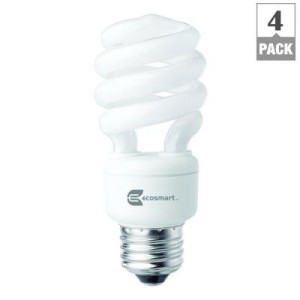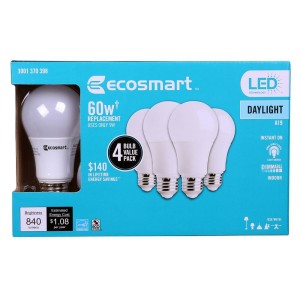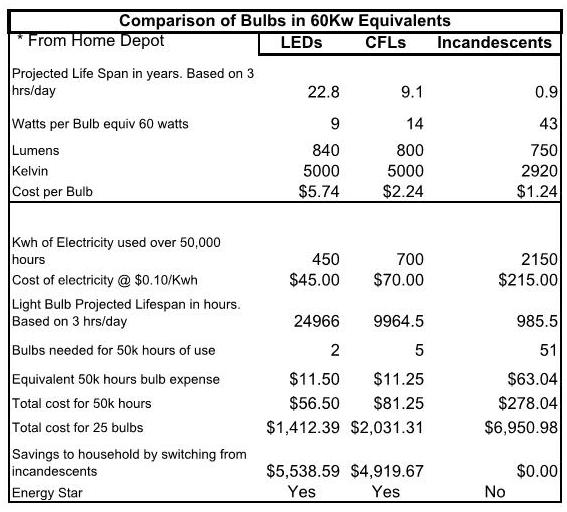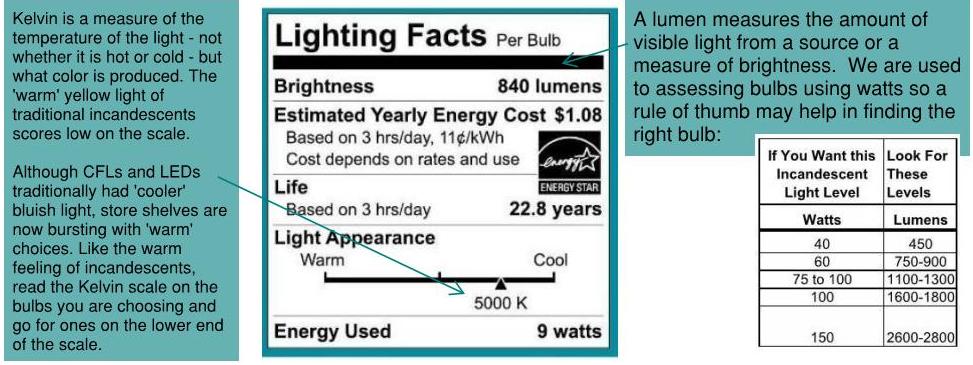Shopped for light bulbs lately? Who knew that anyone would pine for words like soft, bright and, of all things, watts. Now, instead of the little aisles of old that had bulbs with 15, 45, 65 and 100 watts and choices of regular and 3-way controls, we are faced with a 30’ aisle that has every conceivable shape, size, and color imaginable. To top it off, these new bulbs boast a new language on their labels: Lumen, LED, CFL, full spectrum, Kelvin… It almost makes you want to run out of the store. I think even the light bulb manufacturers realize that using such precise but unknown language confuses consumers, thankfully words like WARM are making a comeback.
Kelvin and its cohorts have always lurked behind the marketing words of WARM and DAYLIGHT. Lighting designers have always needed and used precise measurements to get the effects they want and scientists have used specific light measurements in experiments. But what about all of us consumers? We just want comfortable light to work, read and live by.
So why are there so many choices? Until recently we all used a form of the incandescent bulb that Thomas Edison developed and sold…my Great-Grandfather was one of his inventory control managers. Great guy, Edison. The light he provided was life changing BUT much of the energy his bulbs consume is converted to heat – not light. That means that when you turn on an incandescent bulb you are actually wasting energy. So much energy that Congress actually agreed with each other and declared that all bulbs become more efficient. This has effectively killed the incandescent.
After panicking, manufacturers looked around and said, “hey, we are already good at making fluorescent bulbs so why not squish that technology into an Edison bulb shape and socket?!” Voila! the CFL (Compact Fluorescent Light). CFL’s waste very little energy, provide good light, and are dimmable. In an effort to save energy, consumers purchased them by the millions. Problem?:
bulbs so why not squish that technology into an Edison bulb shape and socket?!” Voila! the CFL (Compact Fluorescent Light). CFL’s waste very little energy, provide good light, and are dimmable. In an effort to save energy, consumers purchased them by the millions. Problem?:
- CFL life span decreases if they are frequently switched on and off
- They sometimes hum and take a while to warm up
- And they pose disposal complications… CFLs contain mercury and should be disposed of as hazardous waste. When the bulb breaks in your hand and the mercury escapes are you going to die? The experts say no; I say be careful. Oh yeah, and avoid buying CFLs because you have another choice – LEDs.
LEDs are a versatile group. They used to be incredibly expensive but the price has dropped significantly making them just a little bit more expensive than CFLs. I like them because:
- They provide great light
- They are instant on
- There is no warm-up period where you wonder if the light is broken.
- They do not hum
- They are dimmable
- They come in all shapes, sizes and colors.
- And they use very little energy
That last bit – they use very little energy – is key. The following chart  compares the savings from changing the bulbs in your house to LEDs or CFLs from Incandescents. Over the course of your home ownership, you could save over $5,000 by switching to LEDs. So don’t let the labels intimidate you. Get out there and change out your bulbs and start saving now.
compares the savings from changing the bulbs in your house to LEDs or CFLs from Incandescents. Over the course of your home ownership, you could save over $5,000 by switching to LEDs. So don’t let the labels intimidate you. Get out there and change out your bulbs and start saving now.
If changing out the whole house at once is too expensive, pick the rooms you use most and start with them. You will save money on your electric bill by reducing demand from the power plant. Tell your neighbors and fellow club members to change out their bulbs – if all of us reduce our demand, the power company might be able to NOT build that next power plant. That will mean reduced emissions and less carbon. That means that YOU, by changing out your lightbulb, has made a first step in saving the environment and making the planet healthier and safer for us all.

